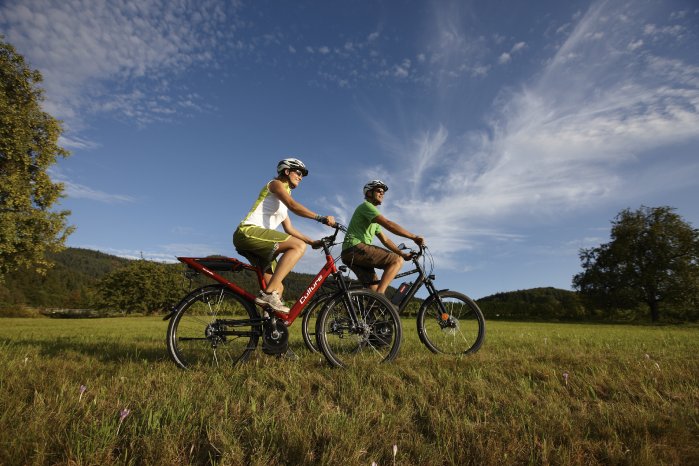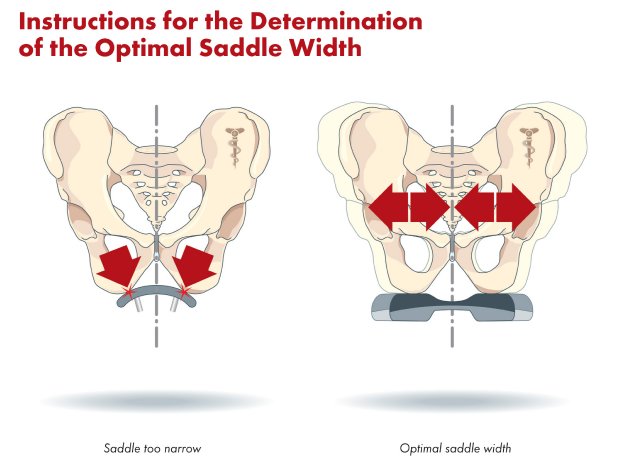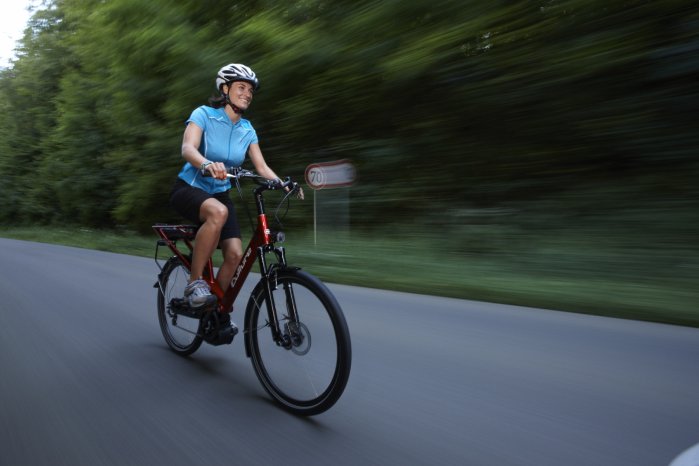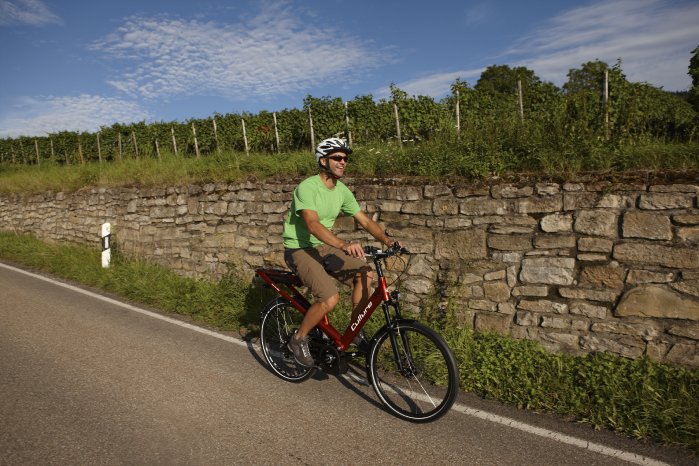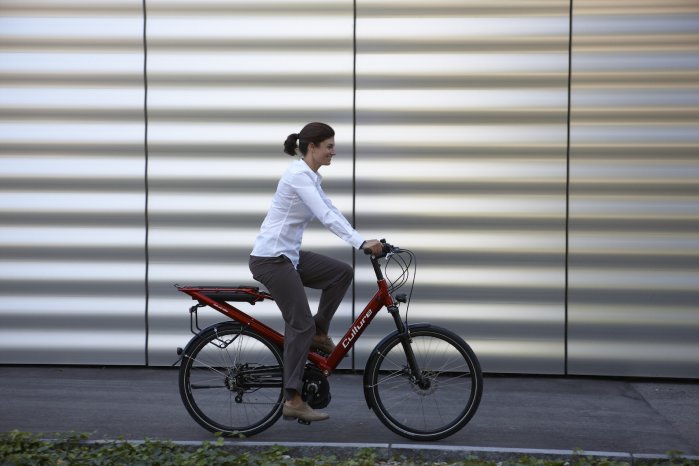Bikes would appear to be a good concept all round, but experts do warn people about using conventional bicycles, such as the oh-so popular mountain bikes or high-performance racing bikes. People already suffering with back problems may find that such these do more harm than good, or even trigger backache in the first place. They are therefore not necessarily recommended for all and sundry without further ado. Top priority must be given to the well-being of the whole locomotor system in general, and to the back in particular that is under such strain. Everyday cycling has only recently started to take account of ergonomic aspects, combined with individually adjustable cycling technology.
Just like any other means of transport, a bicycle also has to offer its users the best possible ergonomic design and sitting comfort as well as being easy to use. Bikes with full suspension are also ideal in this respect. Key purchasing arguments should therefore be based also on "back-friendly" aspects rather than focussing purely on design and price.
Professor Dr. Ingo Froböse, Head of the "Centre for Health" at German Sport University Cologne explains: "Optimum posture on the bike with the upper body leaning forwards slightly applies pretension to the back muscles and stabilises the torso. The cyclic movement of the legs stimulates the muscles particularly in the lower spine. (...) Stimulation of the muscles strengthens them at the same time, thus protecting the spinal column from external stresses."
7 points to observe when purchasing a bicycle
Aktion Gesunder Rücken (AGR - Campaign for Healthier Backs) e. V. lists the aspects you need to consider when purchasing a new bike, and commends particularly back-friendly models.
- The geometry of the bicycle frame should permit a back-friendly sitting position that is as upright as possible or with the upper body leaning forward slightly. It is all right for the upper body to lean forward up to max. 30%. To this end, the handlebars should be about 20 centimetres higher than the upper edge of the saddle.
- The more upright the sitting position, the more weight there will be on the saddle. This puts added alternating strain on the buttock bones with every pedal movement, so that it is also important to adapt the saddle to these movements. A comfortable saddle is therefore vital, not just for long distances. The new saddle technology by ergonomics specialists SQlab (www.sq-lab.com) for example warrants concurrent movement of the pelvis, thus minimising possible negative effects for the lumbar spine, pelvis and hips. A dynamic saddle design also compensates for differences such as leg length difference, for example. The saddle should preferably be put through its paces in a lengthy trial run. Professional advice will soon help to find a suitable model for the individual requirements; initially this entails measuring the distance between the sitting bones. To find the individually ideal saddle, the bicycle dealer measures the distance between the cyclist's sitting bones. This is because the sitting bones must be positioned firmly on the saddle (and not outside it) to take the body weight and thus relieve the pressure on the perineum. But even the best adapted saddle shape cannot help if the saddle tilt is not correctly adjusted. If the cyclist sits firmly on the sitting bones, no nerves will be trapped by the nose of the saddle, even on longer journeys.
- A low step-through is not only comfortable but above all kind to the back. It makes it much easier to get onto and off the bike and poses far less of a danger in unforeseeable or hurried situations than the so-called man's or cross-bar bike. Men should also choose a comfortable model in the interests of their backs.
- The feet play a central role as they are used for power transmission, like the engine of a car. The joints should therefore be protected as far as possible. The load is the lowest when the ball of the foot is directly on the pedal axle. A gear system also helps to protect the joints; people living in hilly country will particularly appreciate a gear system when using a bicycle regularly. Nor should the knee joints be neglected in this context: here the right saddle height is of fundamental significance. The knee should never be fully stretched at the bottom of the pedal movement and should be bent at an angle of about five per cent to prevent excessive stretching of the knee and to stop the hip from tipping forward.
- Backache and neck pain are frequently caused by handlebars of an anatomically incorrect height and shape. Here it is important that the handlebar height and tilt can be adjusted. The aim is for the buttocks to take most of the support load, rather than the wrists. It would also be ideal for the cyclist to be able to change the gripping position on the handlebars.
- Bicycle suspension can help to minimise the bumps and jolts caused by curb stones, potholes and other uneven surfaces. According to the German Sport University Cologne, full bicycle suspension reduces the burden for the spinal column by 35%! It also enhances cycling safety while prolonging the service life of the bike. Ideally, the suspension of the front and rear wheel should be adjusted according to the user's bodyweight.
- As a general rule, the bicycle itself should weigh as little as possible, to make it easier to handle when carrying, parking and lifting.
To be on the safe side when buying a bicycle and to find it easier to make a choice given the huge range available, bicycles have been subject to objective independent testing. "Back-friendly" products that satisfy the strict test criteria of a committee of medical/therapeutic experts are therefore awarded the "certified and recommended" seal of approval of Aktion Gesunder Rücken (AGR - Campaign for Healthier Backs) e. V.
The Avenue, Culture and Jetstream models with full suspension by riese und müller from Darmstadt (www.r-m.de) are the trailblazers in this respect, meeting the strictest requirements in terms of quality and health protection. Advice plays a very important role when purchasing a bicycle, so that AGR provides training on medical issues among others for bicycle shops and retailers; on passing the examination, these are then commended as AGR-certified retailers.
Pedelecs conquer the hearts
People suffering from injuries or cardiovascular illnesses generally have a restricted limit to their physical capabilities and need a gentle approach to start exercising again: here bicycles with electrical assistance may be the perfect solution. These so-called pedelecs are adapted to the personal pedalling capability. State-of-the-art developments make them very uncomplicated to use, with a long battery running time (min. 40 km), and they can also be recharged easily at any power point. Here too there are various AGR-certified models that fulfil the medical criteria in every respect.
Thanks to technical progress, really everyone can improve their quality of life by cycling. It's not just lots of fun but also makes a major contribution to prevention and rehabilitation. These are just some of the reasons why for many years now, cycling has been one of the most popular mass sports; what's more, bicycles are also one of the most environmentally friendly means of transport for short distances. According to Professor Dr. Froböse, the first objective of health-oriented cycling should be to cycle regularly. Regular exercise is the only way to achieve most physical and psychic changes. In any case, the mixture of ergonomic aspects and individually adjusted cycling technology must be put to widespread use in the interests of public health.
More information about bicycles, the AGR, the seal of approval and other tested products together with a list of trained, certified retailers can be found at www.agr-ev.com.
Brief & concise:
Cycling is one of the most effective ways of staying fit and healthy as it brings the whole body into top form. But caution is required: cycling on the wrong bike will often harm the back. After all, everyday cycling has only recently started to take account of ergonomic aspects combined with individually adjustable cycling technology. The Aktion Gesunder Rücken (AGR - Campaign for Healthier Backs) e. V. shows you which points need special attention when buying a new bike and commends particularly back-friendly models according to the strict test criteria of a committee of medical/therapeutic experts. More information is available at www.agr-ev.com.
